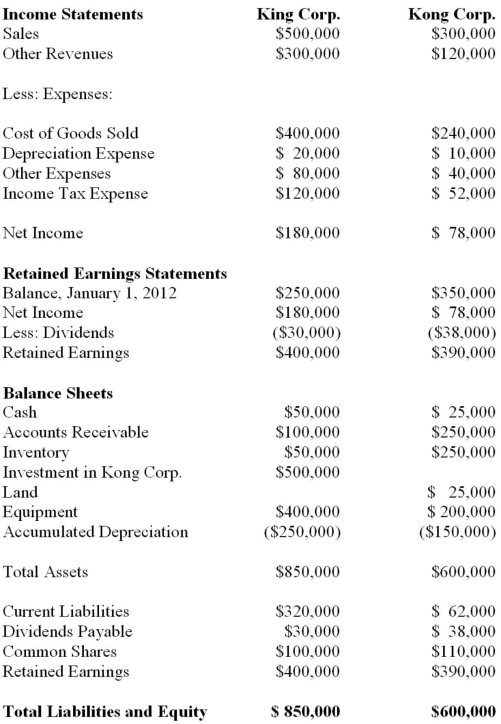King Corp. owns 80% of Kong Corp. and uses the cost method to account for its investment, chapter) Corp. for the Year ended December 31, 2012 are shown below:  Other Information: ▪King sold a tract of Land to Kong at a profit of $10,000 during 2012. This land is still the property of Kong Corp.
Other Information: ▪King sold a tract of Land to Kong at a profit of $10,000 during 2012. This land is still the property of Kong Corp.
▪On January 1, 2012, Kong sold equipment to King at a price that was $20,000 higher than its book value. The equipment had a remaining useful life of 4 years from that date.
▪On January 1, 2012, King's inventories contained items purchased from Kong for $10,000. This entire inventory was sold to outsiders during the year. Also during 2012, King sold Inventory to Kong for $50,000. Half this inventory is still in Kong's warehouse at year end. All sales are priced at a 25% mark-up above cost, regardless of whether the sales are internal or external.
▪Kong's Retained Earnings on the date of acquisition amounted to $350,000. There have been no changes to the company's common shares account.
▪Kong's book values did not differ materially from its fair values on the date of acquisition with the following exceptions:
▪Inventory had a Fair value that was $20,000 higher than its book value. This inventory was sold to outsiders during 2012.
▪A Patent (which had not previously been accounted for) was identified on the acquisition date with an estimated fair value of $15,000. The patent had an estimated useful life of 3 years.
▪There was a goodwill impairment loss of $4,000 during 2012.
▪Both companies are subject to an effective tax rate of 40%.
▪Both companies use straight line amortization. What would be the amount appearing on the December 31, 2012 Consolidated Statement of Financial Position for inventories?
Definitions:
Father-Absent Homes
Households where the biological father is not present, often leading to potential impacts on child development and well-being.
Underweight Girls
Refers to females, typically children or adolescents, who weigh significantly less than what is considered healthy for their age and height.
Moral Reasoning
The process of determining what is right and wrong in a given situation, based on ethical principles and values.
Conventional
Following traditional practices or norms; not novel or unconventional.
Q2: The rate charged by commercial banks for
Q4: Which of the following theories does NOT
Q5: IOU Inc. purchased all of the outstanding
Q8: Parent and Sub Inc. had the following
Q16: Gains and losses on fair-value-through-profit-or-loss securities:<br>A) are
Q17: Which of the following statements regarding the
Q24: You received a $5,000 loan at the
Q38: State Hospital has two service departments (Patient
Q72: The grade point averages for 10
Q79: Total costs are $180,000 when 10,000 units